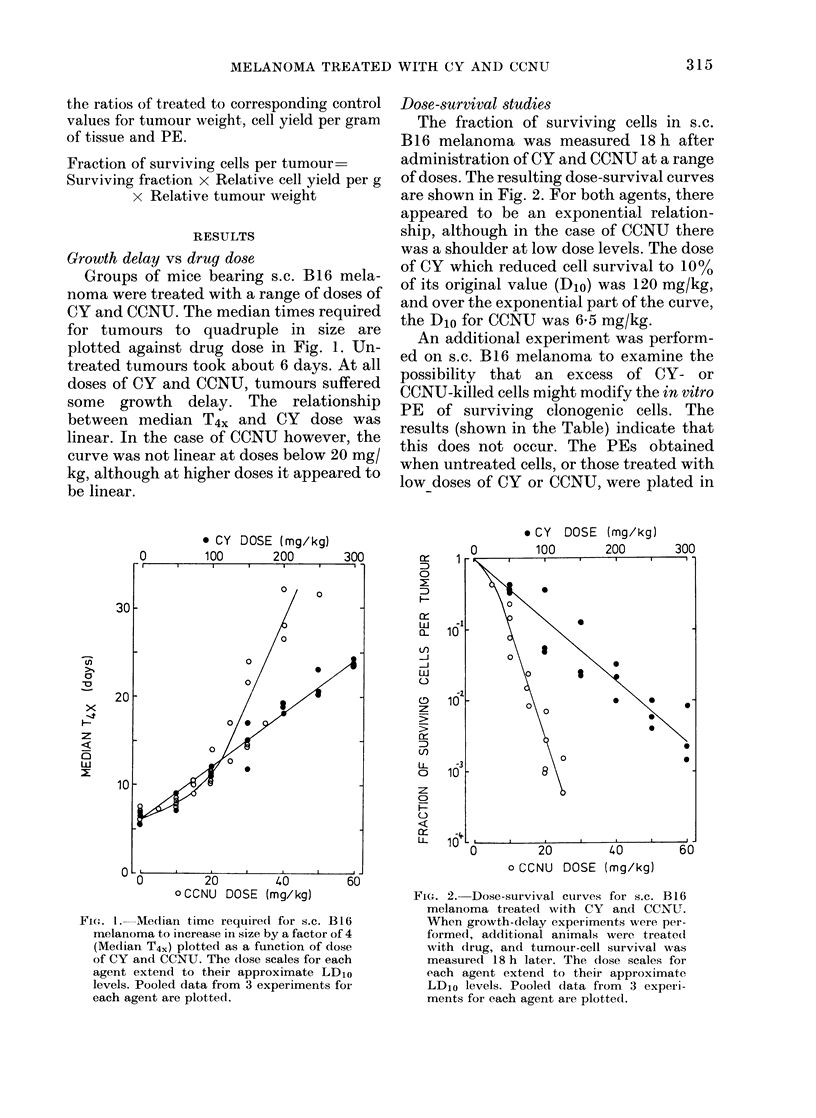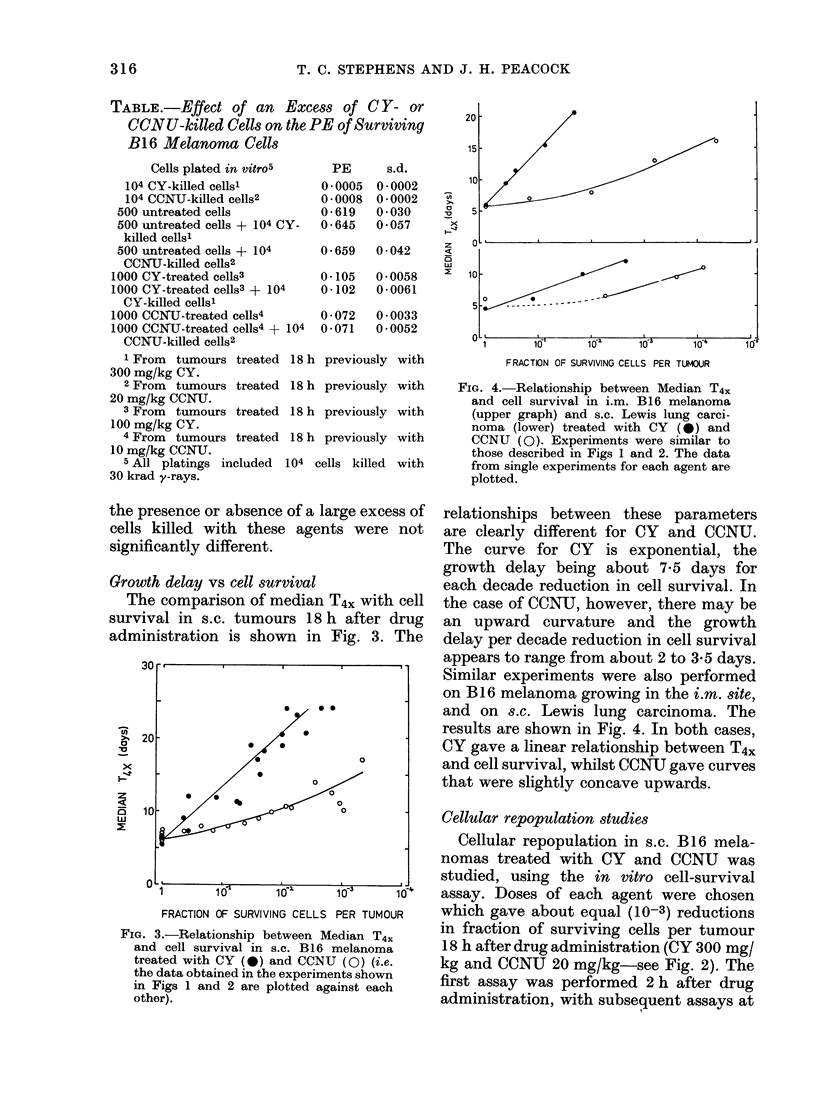Abstract
The relationship between tumour volume response and cell kill in B16 melanoma following treatment in vivo with cyclophosphamide (CY) and 1-(2-chloroethyl)-3-cyclohexyl-1-nitrosourea (CCNU) was investigated. Tumour volume response, expressed as growth delay, was estimated from measurements of tumour dimensions. Depression of in vitro colony-forming ability of cells from treated tumours was used as the measure of tumour cell kill. The relationship between these parameters was clearly different for the two agents studied. CY produced more growth delay (7.5 days) per decade of tumour cell kill than CCNU (2 to 3.5 days). The possibility that this was due to a technical artefact was rejected in favour of an alternative explanation that different rates of cellular repopulation in tumours treated with CY and CCNU might be responsible. Cellular repopulation was measured directly, by performing cell-survival assays at various times after treatment with doses of CY and CCNU which produced about 3 decades of cell kill. The rate of repopulation by clonogenic cells was much slower after treatment with CY than with CCNU, and this appears to account for the longer duration of the growth delay obtained with CY.
Full text
PDF








Selected References
These references are in PubMed. This may not be the complete list of references from this article.
- Blackett N. M., Courtenay V. D., Mayer S. M. Differential sensitivity of colony-forming cells of hemopoietic tissue, Lewis lung carcinoma, and B16 melanoma to three nitrosoureas. Cancer Chemother Rep. 1975 Sep-Oct;59(5):929–933. [PubMed] [Google Scholar]
- Courtenay V. D. A soft agar colony assay for Lewis lung tumour and B16 melanoma taken directly from the mouse. Br J Cancer. 1976 Jul;34(1):39–45. doi: 10.1038/bjc.1976.119. [DOI] [PMC free article] [PubMed] [Google Scholar]
- DULBECCO R., VOGT M. Plaque formation and isolation of pure lines with poliomyelitis viruses. J Exp Med. 1954 Feb;99(2):167–182. doi: 10.1084/jem.99.2.167. [DOI] [PMC free article] [PubMed] [Google Scholar]
- Hahn G. M., Ray G. R., Gordon L. F., Kallman R. F. Response of solid tumor cells exposed to chemotherapeutic agents in vivo: cell survival after 2- and 24-hour exposure. J Natl Cancer Inst. 1973 Feb;50(2):529–533. doi: 10.1093/jnci/50.2.529. [DOI] [PubMed] [Google Scholar]
- Hahn G. M., Rockwell S., Kallman R. F., Gordon L. F., Frindel E. Repair of potentially lethal damage in vivo in solid tumor cells after x-irradiation. Cancer Res. 1974 Feb;34(2):351–354. [PubMed] [Google Scholar]
- Hill R. P., Stanley J. A. The response of hypoxic B16 melanoma cells to in vivo treatment with chemotherapeutic agents. Cancer Res. 1975 May;35(5):1147–1153. [PubMed] [Google Scholar]
- Little J. B., Hahn G. M., Frindel E., Tubiana M. Repair of potentially lethal radiation damage in vitro and in vivo. Radiology. 1973 Mar;106(3):689–694. doi: 10.1148/106.3.689. [DOI] [PubMed] [Google Scholar]
- Lloyd H. H. Estimation of tumor cell kill from Gompertz growth curves. Cancer Chemother Rep. 1975 Mar-Apr;59(2 Pt 1):267–277. [PubMed] [Google Scholar]
- McNally N. J. A comparison of the effects of radiation on tumour growth delay and cell survival. The effect of oxygen. Br J Radiol. 1973 Jun;46(546):450–455. doi: 10.1259/0007-1285-46-546-450. [DOI] [PubMed] [Google Scholar]
- McNally N. J. A comparison of the effects of radiation on tumour growth delay and cell survival. The effect of radiation quality. Br J Radiol. 1975 Feb;48(566):141–145. doi: 10.1259/0007-1285-48-566-141. [DOI] [PubMed] [Google Scholar]
- McNally N. J. The effect of an hypoxic cell sensitizer on tumour growth delay and cell survival. Implications for cell survival in situ and in vitro. Br J Cancer. 1975 Nov;32(5):610–618. doi: 10.1038/bjc.1975.268. [DOI] [PMC free article] [PubMed] [Google Scholar]
- Steel G. G., Adams K., Barrett J. C. Analysis of the cell population kinetics of transplanted tumours of widely-differing growth rate. Br J Cancer. 1966 Dec;20(4):784–800. doi: 10.1038/bjc.1966.90. [DOI] [PMC free article] [PubMed] [Google Scholar]
- Stephens T. C., Peacock J. H., Steel G. G. Cell survival in B16 melanoma after treatment with combinations of cytotoxic agents: lack of potentiation. Br J Cancer. 1977 Jul;36(1):84–93. doi: 10.1038/bjc.1977.158. [DOI] [PMC free article] [PubMed] [Google Scholar]
- Twentyman P. R., Bleehen N. M. Studies of "potentially lethal damage" in EMT6 mouse tumour cells treated with bleomycin either in vitro or in vivo. Br J Cancer. 1975 Oct;32(4):491–501. doi: 10.1038/bjc.1975.251. [DOI] [PMC free article] [PubMed] [Google Scholar]
- Twentyman P. R. Sensitivity to cytotoxic agents of the EMT6 tumour in vivo: tumour volume versus in vitro plating. 1. Cyclophosphamide. Br J Cancer. 1977 Feb;35(2):208–217. doi: 10.1038/bjc.1977.28. [DOI] [PMC free article] [PubMed] [Google Scholar]


